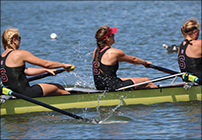UHR NEWSROOM
When working with others to produce stellar results, whether it’s a project team, your departmental co-workers, or a cross-discipline committee, collaboration quickly becomes a key skill. When considering team effectiveness, it can be useful to evaluate results, process, and relationships as three separate but equally important factors.
These factors are a core component of curriculum materials used in Stanford's leadership development classes and programs, submitted by Julie Turchin in Learning & Organizational Effectiveness:
Results
 Set clear goals. Take the time to ensure everyone is clear and aligned on the goals of the collaboration—if some think the goal is to increase efficiency and others think it is to increase customer satisfaction, the group will struggle from the start.
Set clear goals. Take the time to ensure everyone is clear and aligned on the goals of the collaboration—if some think the goal is to increase efficiency and others think it is to increase customer satisfaction, the group will struggle from the start.- Communicate how decisions will be made. Does everyone need to agree? What happens if consensus is not possible? Have a fallback determined and stated up front, or you risk others feeling their trust is broken if their ideas are not implemented.
Process
- Agree on roles. The biggest challenge with collaboration is when work is duplicated or forgotten. What can seem obvious to one person can get lost in translation for others. Take the time at the beginning of the project and at the end of each meeting to clearly state who is responsible for what. Then resist the urge to take on others’ responsibilities.
- Communication. A strong corollary to above is to agree on how progress, changes, and ideas will be communicated. Nothing torpedoes collaborative efforts faster than informal communication channels leaving participants feeling left out, or misunderstandings resulting from missed opportunities to share information with stakeholders.
Relationships
- Build trust by getting to know your collaborators on a personal level. It is not a waste of time; this can keep channels of communication open.
- Address issues early. Strained relationships, wherever they show up, create challenges to effective collaboration. Address behaviors (and encourage others to address them) professionally when they occur.
Faculty Insights on Collaboration
Advice from Graduate School of Education Professor Daniel McFarland, Professor of Sociology and Organizational Behavior (by courtesy), as published in Stanford Business on March 25, 2014, includes insights on how professors form and sustain beneficial collaborations over time. He recalls that his own time limitations and competing research projects led him to have interest in how teams, professional relationships and related connections are manifested. Read more about Professor McFarland's research in the full article: "What is the Secret to a Happy Collaboration?"
Jeffrey Pfeffer, Thomas D. Dee II Professor in the Graduate School of Business, and Robert Sutton, Professor of Management Science & Engineering and, by courtesy, of Organizational Behavior at the Graduate School of Business have written about collaboration vs. competition within organizations for many years. In "The Perils of Internal Competition" from 1999, they write that "management practices that emphasize competition are so common..." and that "Each of these practices creates a zero-sum situation where the success or rewards of one person or department must come at the expense of another." Competition at the expense of collaboration can result in a lose-lose situation in the workplace. In 2005, Professor Pfeffer wrote "Untested Assumptions May Have a Big Effect," which reviewed how critical the mindset of senior leaders can be when implementing the practices that define organizations, which applies to how collaborative or competitive an organization is.
This year, Professor Pfeffer posted a video, "Power and How to Get It," which includes insights on social relationships, a critical component of collaboration in the workplace.
Building Collaboration Skills
Want to build your collaboration skills? Here are some on-campus options:
- The Office of Public Affairs offers Breakfast Briefings that frequently focus on the power and science of collaboration and working effectively in teams. View the Breakfast Briefings upcoming schedule.
- This fall, Learning & Organizational Effectiveness (L&OE) will offer Building Relationship Versatility, a workshop designed to foster stronger relationships and increased collaboration through the use of effective communication approaches. Participants will learn to understand differences in others' behavior and discover ways to increase their effectiveness when working with others to improve communication, persuade effectively, and reduce conflicts. Login to STARS for enrollment details.
- Technology Training in IT Services offers classes that help you build technical collaboration skills, from the use of the secure Box application to Agile project management approaches to the use of BlueJeans for virtual meetings. View the Technology Training upcoming schedule.
Share your ideas
If you’ve had a positive collaboration experience in the workplace and have additional tips to share, please send your ideas to hrcommunications@stanford.edu.

